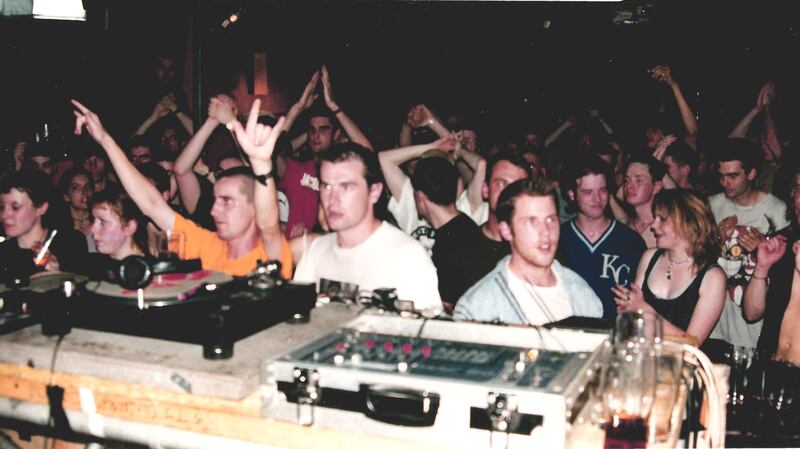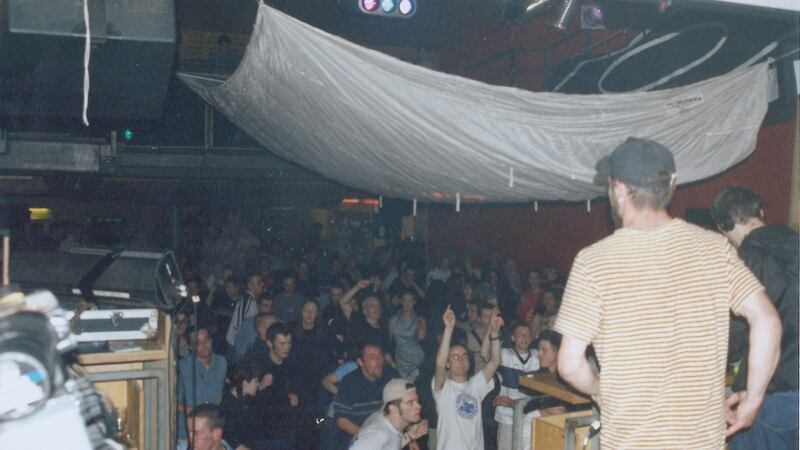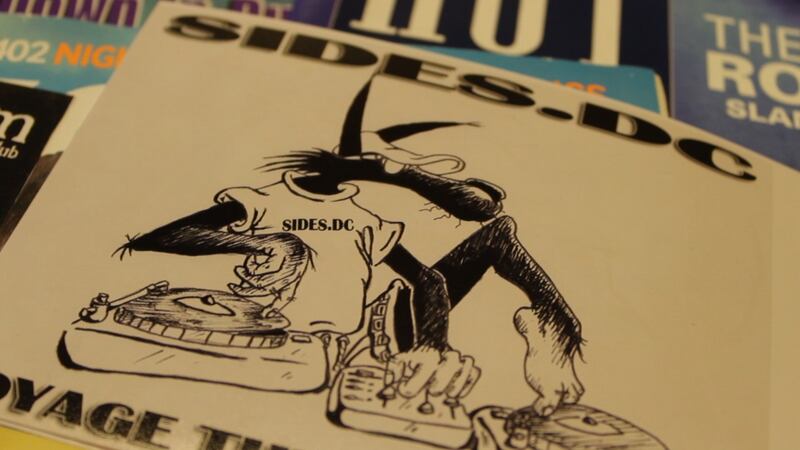Few subcultures have ever been as focused on in-the-moment hedonism as 1990s rave culture. It was a frantic time, with new records, new sounds and new styles every few months.
The emergence of new technologies and aesthetics combined with a focus on community and physical togetherness to create, for many young people, an almost utopian outlook. It was new, it was transgressive, it was an energy all its own.
The very elements that made the first explosion of club culture in Europe such a phenomenon also contribute to the difficulty in talking about it now. Venues are gone, former institutions have disappeared without a trace. Memories are hazy. People move on.

Notes on Rave in Dublin, a new documentary produced by DCTV and Rabble magazine, aims to tell the story of clubbing in the Irish capitol for the first time. Mixing archive footage and salvaged photographs with contemporary interviews, the documentary explores the rise of dance music from its early days in the city's gay clubs through its commercial peak in the mid-1990s and on to the turn of the millennium.

"It was a buried history, and I thought it was odd that nobody had ever looked at it as a scene," says director James Redmond, a journalist and activist in his early 30s. He is also a member of the editorial collective around Rabble magazine, one of Dublin's most prominent alternative magazines.
We meet in a cafe in the north inner city, a stone’s throw from the O’Connell Street area that was once ground zero for many of the clubs and communities featured in the film.
New generation
Redmond says the idea for the documentary had been knocking around for years, with scraps of information picked up online mixing with stories he’d hear from older ravers.
In 2012, just as a burgeoning new generation of dance music producers, DJs and promoters made their marks on Dublin, he decided to explore the history that lay behind this fresh burst of energy.
I wanted to look into what that backstory might be
"If you look at other cities like Berlin, London, Bristol, Manchester, Sheffield, anywhere, there's always a backstory," he says. "Dublin never really had one of those. It had whatever backstory a brand would choose to interject into it, like Red Bull or whatever, to suit their own marketing purposes. I kind of wanted to look into what that backstory might be."
After conducting dozens of interviews, Redmond was drawn more and more to the early days of dance music in the city, and he realised he could tell a story that hadn’t yet been heard.
“It was a pretty ready-made narrative of a generation. Ending with the Creation raves, the burnout of that generation, or them pushing things as far as they could into the early 2000s – it just seemed like a proper pause or full stop. There was no point in trying to hammer what they did into a backstory for this generation, a passing of the baton or anything like that.”
The film begins with Flikkers, a legendary gay club that operated out of the basement of the National LGBT Federation’s Hirschfield Centre in Temple Bar. The centre, named after a German gay rights reformer whose Institute for Sexual Research was torched by the Nazis, was a “social centre for a community that was completely ostracised and effectively illegal”, Redmond says.
“Until the Hirschfield building was itself burned out in 1987, Flikkers was pivotal in both bringing people to the centre and providing the cash to maintain its vital services.
“Flikkers funded the whole infrastructure of that movement at that time. You can see flyers in the film with the ‘Talk to a Friend’ lifeline, these services that are taken for granted and State-funded now, they were providing them at the time out of money they took on that door.
“Even stuff like early sexual health awareness in the middle of an Aids crisis, activities that were basically illegal because it was ‘obscene’.
“You weren’t allowed to provide this information,” he says. “The only way it could get out there was through the money raised by that club.”
National panic
After the tragic end of Flikkers, new clubs such as Sides, the Olympic Ballroom and the Asylum took up the slack, and dance music began to expand both its sound and its audience. The film charts this changing scene as it grows from a niche interest to a national panic leaving drug raids, warehouse raves and dead bodies in its wake.
People from across the social spectrum found themselves rubbing shoulders (and each other's backs)
Redmond mentions a raid on the UFO Club, then based in Columbia Mills on Sir John Rogerson’s Quay, as a moment when the attention of the Garda became impossible to ignore. Twenty-five people were arrested. “It was a criminalisation of the scene.”
One poignant thread running through the film is the role Dublin’s dance clubs played in breaking down class barriers, at least temporarily. People from across the social spectrum found themselves rubbing shoulders (and each other’s backs) in the darkened rooms of Sides and the Mansion House.
Despite the quick transition from a “black and white” era of recessionary Catholic Ireland to a utopian, day-glo rave culture, Redmond says the sense of unity and togetherness of the scene’s early days was destined to dry up at some stage.

“It probably lasts for a honeymoon period, but class society quickly reimposes itself, and commercial interests certainly do,” he says. “I think the scene did stratify again quite quickly. Maybe the power is that it gives people a glimpse of what’s possible. You meet people that you wouldn’t meet in any other context. That’s the force of it.”
Late bar extension
Notes on Rave in Dublin ends in the early years of the new millennium, looking at the last raves in the then-deserted docklands and the rise of the Dublin Electronic Arts Festival.
Redmond suggests that the introduction of late bar extensions in 2003 fundamentally changed the make-up of the club scene, decimating nightclubs by allowing pubs to stay open just as long without many of the same expenses.
People want to gather together and dance in safe venues
He also highlights a more fundamental issue: the Public Dance Hall Act of 1935. The film opens with a quote from the law, which he says remains a barrier to a more liberated, more diverse and more successful nightlife culture in Ireland.
“Why can’t we have art venues that put on events with DJs?” Redmond asks, visibly agitated. “Because there’s an Act that was put in place in 1935 on foot of a racialised campaign against jazz. That’s the fact.
“People want to gather together and dance in safe venues. We’re not allowed do that because of some act from 80 years ago.”
Rave on: four key venues on the Dublin scene
Flikkers
Flikkers was where it all started. Running on weekends in the basement of the Hirschfield centre on Fownes Street in Temple Bar, Flikkers was a more than a night-club; it was a meeting place, a journey of discovery, a lifeline. Disco blurred into house over the speakers, and the foundation for nightclubbing in Dublin – particularly the huge success of Sides on Dame Lane – was set in glittering, multi-coloured stone.
The Mansion House
When the alien phenomenon of youths dancing to loud, repetitive beats began to be noticed by the wider community, Worker's Party TD Tony Gregory lead a select committee of government officials to the centre of the scene: the Mansion House. Seeing a huge room full of loved-up, carefree kids dancing to the music – no booze, no fights, no hassle – they gave it the thumbs up.
The Asylum
Perhaps more than any other club in Dublin's history, the Asylum has a certain mythology around it: the rooms were dark, the crowd were hedonistic, the music was fast, hard and relentless. In a way, it was Ireland's first home for proper techno, and the first high-profile spot to succumb to the rising tide of drug-related gang violence in the mid-1990s.
The Funnel
Clubbing hit its commercial stride by 1994, filling the Point and bringing thousands to festival fields, but smaller rooms like the Funnel allowed niche interests to blossom. Home to D1's regular Saturday night techno club, among many others, the Funnel was both the continuation of an established scene and a reset that pointed in a less commercial, more tight-knit, DIY directio
Notes on Rave in Dublin premieres at the Audi Dublin International Film Festival on Friday, February 24th, with a second screening on Sunday, February 26th. diff.ie










